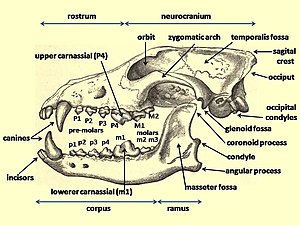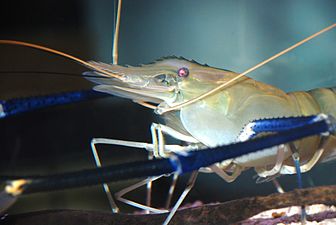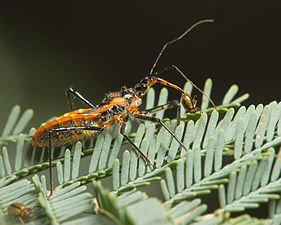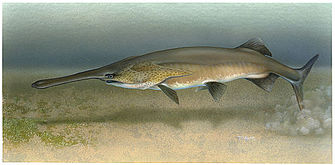Rostrum (anatomy)

Rostrum (from Latin rostrum, meaning beak) is a term used in anatomy for a number of phylogenetically unrelated structures in different groups of animals.

Invertebrates
- In crustaceans, the rostrum is the forward extension of the carapace in front of the eyes.[1] It is generally a rigid structure, but can be connected by a hinged joint, as seen in Leptostraca.[2]
- Among insects, the rostrum is the name for the piercing mouthparts of the order Hemiptera as well as those of the snow scorpionflies, among many others. The long snout of weevils is also called a rostrum.[3]
- Cephalopod molluscs have hard beak-like mouthparts referred to as the rostrum.[5]
- Invertebrate rostrums
-
Crustacean: the rostrum of the shrimp Macrobrachium rosenbergii is serrated along both edges.
-
Insect:assassin bugpiercing its prey with its rostrum
-
Cephalopod: the two-part beak of a giant squid
-
Proboscis of hawk-moth (Agrius convolvuli)
Vertebrates

In mammals, the rostrum is that part of the
zygomatic arches, where it holds the teeth, palate, and nasal cavity.[6] Additionally, the corpus callosum
of the human brain has a nerve tract known as the rostrum.
The beak or snout of a vertebrate may also be referred to as the rostrum.
- Some beaked whales, have rostrums (beaks) which evolved from their jawbones. The narwhalpossesses a large rostrum (tusk) which evolved from a protruding canine tooth.
- Some laterally(sideways).
- The upper jawbones of some fish have evolved into rostrums
-
The paddlefish has a rostrum packed with electroreceptors
-
Sawfish have an electro-sensitive rostrum (saw) which is also used to slash at prey
See also
- Beak – Part of a bird
- Nostril – Pair of orifices of the nose
- Snout – Extended part of an animal's mouth
References
- ^ Charles Drew (November 17, 2003). "Crustacea". University of Bristol. Archived from the original on July 3, 2012. Retrieved November 7, 2010.
- ISBN 978-0-520-23939-5. Archivedfrom the original on 2020-09-12. Retrieved 2020-09-12.
- ISBN 978-0-85199-655-4.
- ISBN 978-0-471-35837-4. Archivedfrom the original on 2020-09-12. Retrieved 2020-09-12.
- ^ Burt Carter. "Cephalopods". Invertebrate Paleobiology. Archived from the original on 2012-04-02. Retrieved 2011-09-22.
- ^ Elbroch, Mark "Animal Skulls: A Guide to North American Species", Stackpole Books 2006, p9
- ISBN 978-0-08-091993-5. Archivedfrom the original on 2 September 2020. Retrieved 12 September 2020.
- ^ "Basic anatomy of Cetaceans - Dolphins". Robin's Island. Archived from the original on November 17, 2010. Retrieved November 7, 2010.
- PMID 22401891.







